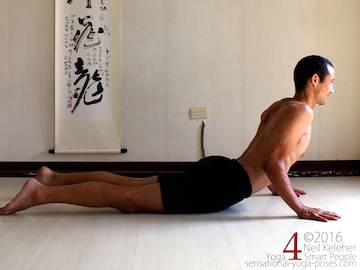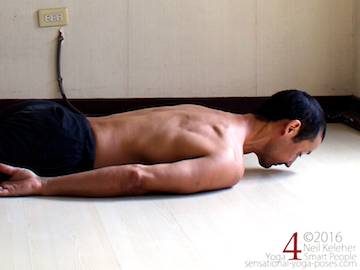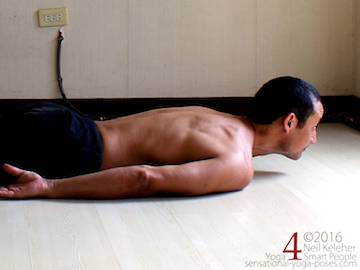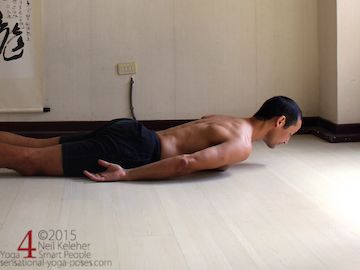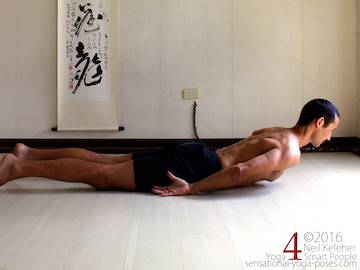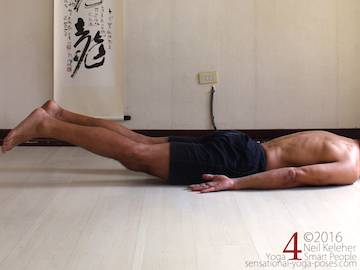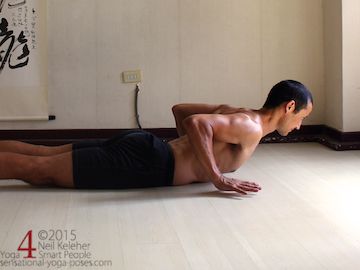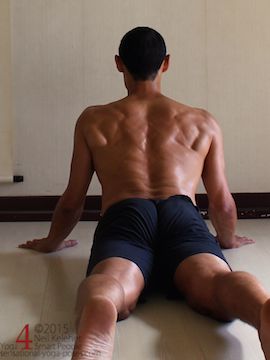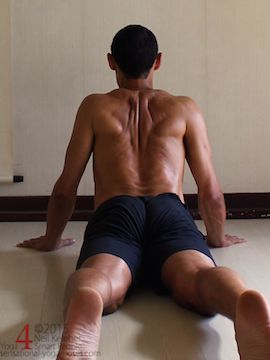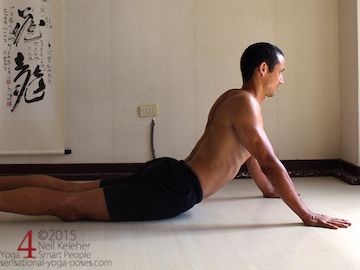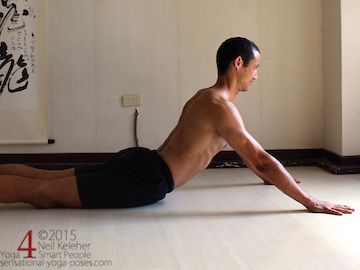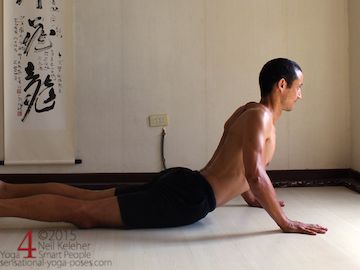Yoga Cobra Yoga Pose
Deepening spinal awareness by bending the spine backwards one vertebral joint at a time
My usual method for teaching cobra yoga pose is to start with locust pose.
The idea of using locust pose as a start is to learn how to feel the spinal erectors activating. These are the muscles that run up and down along either side of the spine. They can be used to bend the spine backwards.
The challenge with cobra pose is getting students to use their spinal erectors even though they are using their arms to help lift their ribcage off of the floor.
One method for getting them to feel their spinal erectors is to bend the spine backwards one vertebrae at a time.
Feeling the Spinal Erectors Activate
In the case of locust, to get them used to feeling their spinal erectors, I'll have students start by lifting their head only (keeping shoulders and ribcage on the floor) and either lengthen the sides of the neck, or lengthen the neck and then bend it backwards.
When bending the neck backwards there will be a noticeable feeling of contraction at the back of the neck. This is the spinal erectors activating (the portion that acts on the neck.)
The next step is to then lift the ribcage and at the same time bend it backwards.
In this case I usually have students keep their neck straight (but long) and focus on lifting the ribcage and bending it backwards. It can be a challenge particularly if not used to bending the thoracic spine backwards.
Increasing Spinal Awareness
For more awareness I'll sometimes teach students to bend their neck backwards one vertebral joint at a time, then bend their thoracic spine backwards one vertebral joint at a time. So that this is more accurate I'll have them count vertebrae.
So for example, when bending the neck backwards, I'll have them bend backwards in seven steps since the neck has seven vertebrae. (The head could be thought of as an eighth "larger" vertebrae.)
When doing the ribcage and thoracic spine I'll divide the ribcage into an upper part and lower part.
The upper part contains 7 vertebrae and corresponds to the ribs that attach to the sternum. Another useful landmark is the shoulder blade. The bottom tip of the shoulder blade is at about the level of the 7th rib (if the shoulder blade is not elevated or slid towards the head).
The lower half of the thoracic spine has 5 vertebrae. The top three of these ribs form the arch at the bottom front of the ribcage. The bottom two are floating ribs whose ends float free from any bony attachment.
The idea is to bend backwards one joint at a time, and usually I'll do this with the breath, so inhale, bend backwards at one joint, exhale, then inhale, moving to the next joint. I'll have students focus on bending the upper ribcage backwards one vertebrae at a time. Then rest. Then repeat the upper ribcage and follow it immediately with backbending the lower half of the ribcage one vertebral joint at a time.
I now have students additionally focus on expanding the ribcage, reaching the ribs away from the pelvis. This then activates the intercostals, the muscles that lay between adjacent ribs.
Upper ribcage bent backwards. Upper and lower ribcage bent backwards.
Glutes and Hamstrings
Other muscles that I like to teach students to activate for cobra pose are the glutes and hamstrings. While not strictly necessary in cobra pose since the pelvis is kept on the floor, activating the glutes and hamstrings can be good training for upward dog pose which I often teach after first having students do cobra.
A simple way to practice activating glutes and hamstrings is to lift only the legs while laying down.
Using Spinal Erectors in Cobra Yoga Pose
To emphasize the use of the spinal erectors I'll have students lay on their bellies with hands on the floor beside their chest. I'll then have them lift their head and lengthen their neck. Then I'll have them lift their ribcage and bend their thoracic spine backwards. So that I know their spinal erectors are activating (and so that they can feel them activating) I'll then have them lift their hands. To make this easier I'll have them move their shoulder blades towards each other. Then I'll have them hold this position for a few breaths.
The next step is to put the hands on the floor and use the arms to lift the ribcage.
My understanding of cobra is that the pelvis stays on the floor. So the arms will probably have to stay bent unless the hands are moved forwards so that then the elbows can be straightened while keeping the pelvis on the floor.
The arms bent variation is harder on the arms but can be used as an arm strengthening exercise.
Now I can't say that there is a problem if the elbows point out, but nonetheless I currently have students point their elbows back in this pose if for no other reason that it trains them to be aware of what direction their elbows are pointing in.
Shoulder Actions in Cobra Yoga Pose
Basic shoulder actions in cobra yoga pose can include spreading the shoulder blades (protraction) which activates the serratus anterior. You could also focus on externally rotating the upper arms. You may find that this helps to draw the bottom tip of the shoulder blade outwards.
Another option with the shoulder blades is to retract them (draw them towards each other.) You may find that it is then easier to lift and open your chest. This is because with the shoulder blades retracted, the serratus anterior muscle are lengthened giving them more room to help open the chest.
Activating the Back of the Body
For the back of the body, I'd suggest activating the gluteus maximus (the butt muscle) and hamstrings. This may cause a feeling like you are pressing your legs into the floor. From there try to activate your lumbar spine erectors (the muscles that bend the lumbar spine backwards) and the thoracic spinal erectors. Then focus on making the sides of the neck long. You may find that this final action helps you to open your ribcage even more.
Straight Arm Cobra
If you do the version with hands forwards and elbows straight (but hips still on the floor) use your shoulders to push your ribcage upwards and backwards. You'll probably find that your shoulder blades will spread as you do this.
Shoulders Relaxed. Using shoulders to push ribcage backwards and upwards.
Elbows Pointing Outwards Cobra?
Once you are comfortable with the elbows pointing back version, do yourself a favor and experiment with pointing the elbows back. Try it with shoulder blade protracted and then retracted.
(And don't forget all of the other points, activate: glutes, hams, spinal erectors and intercostals. In other words, squeeze the butt, hamstrings and back of the spine. Lift and open the ribcage.)
Published: 2011 07 17
Updated: 2020 10 28
